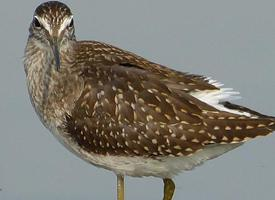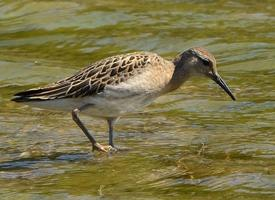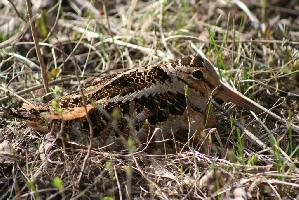
Popis zvířete
The Wood Sandpiper (Tringa glareola) is a small, elegant wader that is part of the sandpiper family, Scolopacidae. This bird is notable for its slender build, delicate features, and distinctive behavior, making it a subject of interest among birdwatchers and ornithologists. With a widespread range that spans across various continents, the Wood Sandpiper is a migratory species that showcases remarkable adaptability and resilience in its life cycle and habits.Physical Description:
The Wood Sandpiper stands out with its slender, graceful body, measuring approximately 19-21 centimeters in length, with a wingspan of around 37-40 centimeters. It weighs between 40 to 90 grams, displaying a light build that is characteristic of wading birds. Its plumage is primarily a mottled brown on the upper parts, blending seamlessly with its habitats, while the underparts are white with fine, dark streaks, providing excellent camouflage against predators. The bird has a long, straight, and pointed bill, which is dark with a grayish base, perfectly adapted for probing into mud and shallow water for food. Its legs are long and slender, colored a striking greenish-yellow, which is particularly visible during flight or when wading through wetlands.
Behavior and Ecology:
Wood Sandpipers are migratory birds, breeding in the subarctic wetlands of Europe and Asia, and wintering in Africa, southern Asia, and Australia. They are highly adaptable and can be found in a variety of wetland habitats, including marshes, swamps, and the edges of lakes and rivers. During migration, they often stop over at agricultural fields, estuaries, and sewage ponds, showcasing their versatility in habitat preference.
Their diet primarily consists of insects, small fish, crustaceans, and annelids, which they skillfully extract from mud and shallow water using their sensitive bills. Wood Sandpipers are known for their distinctive feeding behavior, often seen walking and picking food from the surface or performing a characteristic 'sewing-machine' action as they probe the mud.
Breeding and Reproduction:
The breeding season of the Wood Sandpiper begins in late spring, with nests typically located on the ground, hidden among vegetation in their subarctic wetland habitats. The female lays a clutch of 3-4 eggs, which both parents incubate. The chicks are precocial, hatching fully feathered and able to leave the nest shortly after birth, although they remain dependent on their parents for food and protection for several weeks.
Conservation Status:
The Wood Sandpiper is classified as Least Concern by the International Union for Conservation of Nature (IUCN), indicating that it is not currently at immediate risk of widespread decline. However, like many migratory species, it faces threats from habitat loss and degradation, particularly in its breeding and wintering grounds due to agricultural expansion, wetland drainage, and climate change. Conservation efforts focused on protecting wetland habitats and ensuring safe migration corridors are crucial for the continued survival of this species.
In summary, the Wood Sandpiper is a fascinating bird with a wide range that showcases remarkable adaptability in both its habitat preferences and feeding habits. Its elegant appearance, distinctive behaviors, and the challenges it faces in a changing world make it a symbol of the beauty and resilience of wetland ecosystems.
Podobná zvířata
Nové fotografie zvířat
Top 10 zvířat
- Common house mosquito (Culex pipiens)
- Common cockchafer (Melolontha melolontha)
- Colossal squid (Mesonychoteuthis hamiltoni)
- Hooded merganser (Lophodytes cucullatus)
- Australian box jelly (Chironex fleckeri)
- Fruit fly (Drosophila melanogaster)
- Common reed warbler (Acrocephalus scirpaceus)
- Elephant hawk moth (Deilephila elpenor)
- Moustached guenon (Cercopithecus cephus)
- Diana monkey (Cercopithecus diana)


